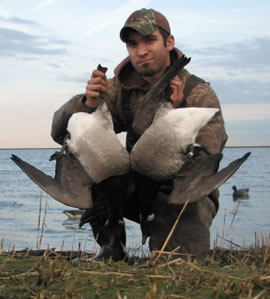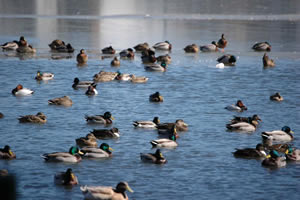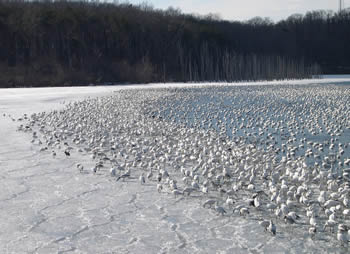2009-2010 Migratory Bird Season
|
||||||||
|
Duck hunting regulations are based on biological population assessments using the Adaptive Harvest Management (AHM) process, which has been developed cooperatively by the Service and Flyway Councils. AHM is an objective, science-based regulation-setting process. During 2009, the AHM process suggested that a liberal duck hunting season in all flyways was consistent with the long-term welfare of North American waterfowl populations. Most species of ducks in the eastern and mid-continent survey areas were near or above their long-term averages. Mallards, black ducks, canvasback, bufflehead and American wigeon were similar to long-term averages while blue-winged and green-winged teal, gadwall, shovelers and redheads were well above long-term averages. The artwork and the paper stamp were discontinued as cost saving measures. Waterfowl stamp fees paid by hunters are dedicated for the acquisition, protection and improvement of waterfowl habitat. Since 1984 the sales of New Jersey waterfowl stamps and prints have raised more than $4,250,000. To date, more than 13,000 acres have been secured for waterfowl though donations of land and funds from waterfowl stamp fees. Wood duck population indices have increased across North America and population modeling efforts done by the Service and Flyways suggest that wood ducks can withstand additional harvest. In 2008, the flyways and Service agreed to a 3-year experiment to increase the wood duck bag limit from 2 to 3 wood ducks of which 2009 is the second year of the experiment. Wood ducks are an important species to New Jersey duck hunters' bags, particularly in the North Zone. |
Although most species are doing quite well, managers remain concerned about scaup and pintails. Scaup populations have remained depressed for more than 20 years. Although the 2009 scaup estimate was 18% below the long-term average, the estimate increased over 2008 warranting a reinstatement of a full season, 2-bird bag limit for scaup. Although pintails were 20% below their long-term average, 2009 population estimates indicated that pintails could sustain a 1 bird per day bag limit through the duration of the 60-day duck season.
This year, the daily bag limit in New Jersey will be 6 ducks and may not include more than 4 mallards (including no more than 2 hens), 4 scoters, 3 wood ducks, 2 redheads, 2 scaup, 1 canvasback, 1 pintail, and 1 black duck. Merganser bag limits will remain at 5 birds per day with no more than 2 hooded mergansers. Merganser bag limits are in addition to regular duck bag limits.
The "regular" Canada goose season is set based on the status of Atlantic Population (AP) Canada geese on the Ungava Peninsula of northern Quebec. The AP is New Jersey's primary migrant Canada goose population. A total of 176,000 breeding pairs were estimated from surveys during June 2009. This estimate is similar to last year. During this year's survey, only 38% of the indicated pairs were observed as single birds, indicative of a poor nesting effort resulting from a very late spring. Reports from banding crews on the tundra breeding grounds during August confirmed that young production was very poor. As a result, the regular season for Canada geese in New Jersey will be remain at 45-days with a 3-bird bag limit.
|
Resident Population Canada geese are overabundant throughout most of the United States and cause significant damage problems. Recently, the Service completed an Environmental Impact Statement that included a multi-faceted approach for managing resident Canada geese. Included in this approach was the expansion of hunting methods during September seasons when generally only Resident Population geese are harvested. Permitted additional hunting methods during September seasons are the use of electronic calls, unplugged shotguns, extended hunting hours, and liberal bag limits. New Jersey has chosen to allow hunters to utilize these tools to help curb the growth of Resident Population geese in the state. Although these special regulations and liberal bag limits alone are not expected to solve the resident Canada goose overabundance problem in New Jersey, they remain part of an integrated approach to Canada goose management. |
HUNTERS NEED TO REMEMBER THAT THESE SPECIAL REGULATIONS ONLY APPLY TO THE SEPTEMBER CANADA GOOSE SEASON (September 1-30, 2009). Hunters that choose to use unplugged guns during the September Canada goose season are reminded to reinstall magazine plugs before pursuing other game species. During all other waterfowl seasons, including ducks, brant, regular and winter Canada goose, and snow goose, "standard" regulations apply. "Standard" regulations include: electronic calls prohibited, shotguns may not be capable of holding more than 3 shotshells, and hunting hours end at sunset.
The Special Winter Canada Goose Season will be held January 19 to February 15, 2010 in two zones with the same hunt area boundaries as last year and a bag limit of 5 Canada geese per day.
Since Atlantic brant breed in remote wilderness of the Canadian Arctic, their status is measured during January surveys on their Atlantic Flyway coastal wintering grounds. In the 2009 Mid-Winter Waterfowl Survey, 151,000 brant were counted which was a 7% decline from the 2008 survey. In addition, spring conditions on Atlantic brant staging and breeding areas were very cold which will result in poor young production. As a result of the reduced population and expected poor production, the brant season length was reduced to 50-days and the bag limit reduced to 2 birds. As a result, the brant season will be closed during the duck season in all zones. Hunters should check the season dates carefully and note the time periods during the duck season when the brant season is closed.
"Light" goose (greater and lesser snow geese as well as Ross's geese are collectively referred to as "light" geese) populations remain high and biologists are concerned about the impacts light geese have on fragile Arctic nesting habitats. Serious damage to Arctic wetlands has already been documented in several key light goose breeding colonies. This damage impacts the light geese themselves, as well as other wildlife dependent on the Arctic ecosystem. Serious damage to agriculture also occurs in migration and wintering areas.
As a result of this overabundance issue, the Service recently completed an Environmental Impact Statement (EIS) on the management of light geese. The preferred alternative in the EIS was to increase light goose harvest through increased hunting seasons and implementation of a Conservation Order (CO). A CO is a special management action, authorized by the Migratory Bird Treaty Act that is needed to control certain wildlife populations when traditional management programs are unsuccessful in preventing overabundance of that population. The CO allows an extended time period outside of traditional hunting seasons as well as additional methods for taking snow geese without bag limits. The intent of the CO is to reduce and/or stabilize North American light goose populations that are above population objectives.
|
In the Atlantic Flyway, greater snow geese are the most abundant light goose population. The preliminary estimate from 2009 spring surveys was 1.4 million birds which is nearly three times the size of the population objective of 500,000 birds. As a result, the hunting season length for light geese will be the maximum allowed under the Migratory Bird Treaty Act (107 days) with liberal bag limits of 15 light geese per day. In addition, a CO will be implemented in the spring of 2010 during February 16 to April 10. During the CO, special regulations will be allowed including the use of electronic calls, shotguns capable of holding up to 7 shells, extended shooting hours, and no bag limits. Hunters interested in participating in the CO should check the migratory bird regulations and/or the Division's web site for more details on obtaining required permits, etc. |
The Service allows states to hold Youth Waterfowl Hunting Days on weekends, holidays, or other non-school days when youth hunters would have an opportunity to participate. New Jersey Youth Waterfowl Hunting Days will be October 3, November 6-7, and October 31, in the North, South, and Coastal Zones, respectively.
All hunters pursuing migratory birds including ducks, geese, brant, coot, woodcock, rails, snipe or gallinules, are reminded to obtain a Harvest Information Program (HIP) certification. The process is the same as in 2008. Migratory bird hunters can get their HIP certification one of three ways: online by visiting the division's license sales web site, at any license agent, or by calling the toll-free NJ telephone sales line at 888-277-2015.
Additional information on the 2009 status of waterfowl and habitat conditions can be viewed on the Service's web site at:www.fws.gov/migratorybirds/NewReportsPublications/PopulationStatus/Waterfowl/StatusReport2009_Final.pdf (pdf, US FWS website)
The 2009-10 New Jersey migratory bird hunting season dates follow. The 2009-10 Migratory Bird Regulations publication will be available at Division offices, license agents, sporting goods stores, and the Division's web site in late summer.
2009-10
Migratory Bird Regulations Booklet (pdf, 108kb) The division wishes all migratory bird hunters a safe and enjoyable
hunting season. See the NJ
Waterfowl and Migratory Birds page for more information about
NJ's migratory birds.
2009-10
Migratory Bird Regulations Summary (pdf, 13kb)
Harvest Information Program
(HIP) Certification Information
|
||
|
|
||
|
||
| |
||



